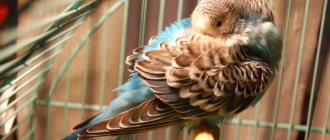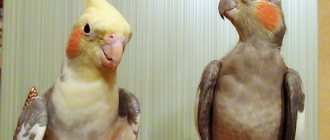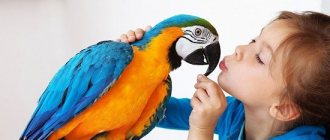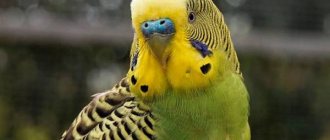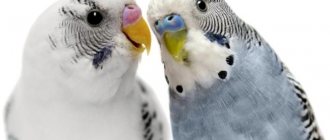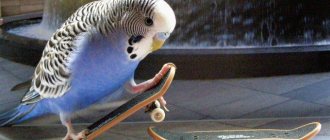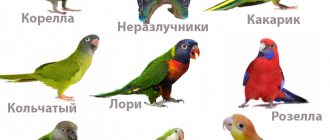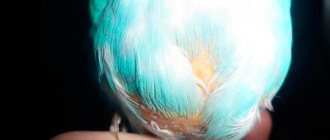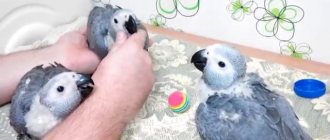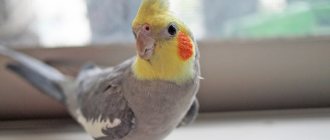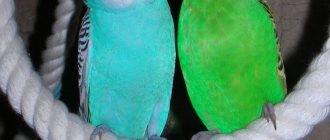Down parasites are parasites that cause significant harm to the health of budgerigars. They are not dangerous to humans because they feed on feathers and skin particles of birds.
It is quite difficult to see them on the body of a down-eater parrot, since they are small in size and grayish-brown in color. The length of the body varies from 1 to 2 mm, but such small parasites can cause irreparable harm to the health of the bird, so if they are identified, it is necessary to undergo surgical treatment.
What it is
The disease caused by exposure to lice beetles is called mallophagosis . For beginners, identifying this disease is quite difficult, since in the first stages of infection the bird’s behavior practically does not change. It is quite difficult to notice insects on feathers due to their small size.
The first signs of infection include a change in the behavior of the parrot, which becomes agitated and restless. The bird often begins to itch or even pull out feathers, so many bare areas appear on its body. The feathers become damaged and many small holes appear on them.
In the photo you can see what the fluff eater looks like:
Preventive measures
When purchasing a bird, remember about the problem of lice-eaters in parrots. Before buying, carefully inspect the bird, make sure that its skin is clean and there are no characteristic needle-like holes on the feathers and the tips are not deformed. If the parrot is purchased from a nursery or brought to order, the accompanying documents must include a certificate from the veterinary and quarantine service.
Thoroughly clean the cage every day, clean all accessories, and periodically disinfect. Wash the branches and grass that you give to the bird. Replace toys, ladders, perches and other elements of the playground that have become unusable.
To repel feather eaters, you can put birch and bird cherry leaves in the cage. And also twigs of wormwood, chamomile, lavender, wrapped in linen, are placed there, since these plants are toxic.
It is better to pre-treat any items intended for a parrot.
Do not allow your pet to come into contact with unfamiliar or street birds.
Use high-quality grain mixtures from trusted manufacturers. Buy feed from reputable suppliers. A balanced diet, mineral and vitamin supplements, and the obligatory presence of greens in the menu will form and maintain good immunity for the parrot.
Closely monitor the physical and emotional state of your feathered friend. Any deviation from normal behavior is a signal of possible ill health of the bird.
How does infection occur?
Periods can appear in a parrot for various reasons:
- contact with an infected individual that gets into the pet’s cage, but usually this situation arises in pet stores or the owner does not comply with quarantine when purchasing a second wavy;
- a person brings parasites home on his clothes;
- using unprocessed twigs to create perches;
- purchasing a cage or accessories that are infected with parasites, so immediately after purchasing any item for a parrot you need to treat it with special protective compounds;
- exposing the cage with the wavy to the open air in the summer.
The owner must independently ensure that his wavy does not become infected with these parasites, which cause serious health problems.
Possible complications
If, upon noticing fleas on a parrot, treatment is not started immediately, parasite bites can lead to unpleasant consequences. The result of pest activity is often the complete loss of plumage by the bird.
In addition, parasites are carriers of typhoid, plague and other dangerous diseases. They weaken the protective properties of the parrot's body, cause anemia and problems with the nervous system.
Reasons for appearance
Most often, fluff eaters appear in a parrot after contact with another infected individual. For example, if a person decides to buy a pair for his pet, then for the first 2 weeks the new individual must be kept in a separate cage.
During this period of time, all diseases or other health problems in the bird are identified. If a new wavy is immediately placed in a pet’s cage, then this becomes the cause of the transmission of many diseases. Additionally, the parasites spread to the pet parrot.
When purchasing a new cage, drinking bowl, feeder or toy, it is necessary to treat this item with special protective compounds. For pets, it is recommended to purchase only high-quality feed mixtures sold in closed packages, since if you take the mixture by weight, there is a high probability that the grains will be infected with various pests.
Has your parrot been sick?
Not really
Habitat disinfestation
When infested with fleas, both the bird and the habitat (cage) are treated. For this purpose, they choose the same drugs that were used to treat the bird. Completely wash all elements of the cage, food and drinking containers. After this, you will need to take everything out into the fresh air for ventilation (from 3 to 6 hours). Toys and mirrors are thrown away.
During the treatment, the parrot is sent to another home, but pre-treated with soda, manganese or another flea remedy. When treating pigeons, birds are allowed into the dovecote only after 6-8 hours. All bedding, hay and other things are taken out and burned.
Symptoms
When the first symptoms of infection appear, it is necessary to promptly begin treatment to avoid negative consequences.
The main symptoms of the presence of lice eaters include:
- the parrot begins to behave restlessly and anxiously, and also refuses to learn and communicate with humans;
- decreased appetite;
- the bird tears out its feathers and constantly itches with its paws and beak;
- in advanced cases, the parrot not only tears out feathers, but also pecks at the skin, which leads to the appearance of sores and bare skin;
- the formation of small black spots on feathers, which are represented by eaten away parts, and they are usually located on the flight or tail feathers.
If you lift a bird's wing, you can see the parasites with the naked eye , since there are few feathers, so the insects are clearly visible on the bare skin. They are represented by small black dots, the size of which does not exceed 2 mm.
Why fleas are dangerous for birds
In the short period of time during which the parasites remain on the budgerigar’s body, they can cause significant harm to its health:
- loss of plumage;
- anemia;
- weakened immunity;
- malfunctions of the nervous system, nervous disorders;
- inflammation of the lymph nodes;
- pediculosis;
- helminthic infestations;
- fever.
Your pet may even get sick with plague or typhus, since fleas are carriers of these serious diseases.
How to get rid of the disease - treatment methods
It is advisable to immediately contact a veterinarian who can prescribe competent treatment if you discover down-eaters. The sick individual is separated from other birds, and the cage in which the wavy was located is disinfected with insecticidal compounds.
Sick birds are treated with commercial drugs sold in the form of a spray or powder. In order to remove the lice eater, it is possible to combine such treatment with traditional methods that reduce the negative impact of parasites.
The main methods of treatment include:
Store-bought sprays. They are easy to use and effective, so they are often used to combat parasites.
The most popular are Frontline and Insectol sprays. The spray is sprayed on the neck and back of the bird’s head, where the wavy cannot reach with its beak, which prevents the drug from getting on the mucous membranes. It is necessary to press the sprayer about twice so as not to overdo it with the composition. Sometimes it is necessary to spray the drug several times a week, for which the number of detected parasites is taken into account. For prevention, it is recommended to repeat the procedure after a week. To prevent overspraying, you can spray the product into the cap and then apply it to the back of the bird's head with a cotton swab. Do not allow the product to come into contact with the bird’s beak, eyes or ears.- Powder. Means for combating fluff eaters are represented not only by sprays, but also by powders. For processing, the powder is poured into a bag made of gauze, after which the wavy feathers are powdered. This method is considered not very safe, since there is a high probability that the insecticide will get on any mucous membrane of the bird.
- Cell processing. To completely destroy the parasites, it is important to treat the cell in which the wavy lives with insecticides. The most aggressive agents, presented in liquid form, are used for the process. Solutions of disinsectal or neostomozan are used. After treatment, the cell is washed with water and dried. It is recommended to repeat this procedure periodically to prevent the reappearance of parasites.
- Folk methods. They alone cannot cope with the destruction of pests, so they are used as an auxiliary means. To relieve itching and inflammation, baths made from infusions of chamomile and calendula are used. A more concentrated solution can be rubbed into the bird’s feathers. Treatment is carried out for three days, after which a break is taken for 5 days. Another method is to use sulfur powder or pyrethrum. To do this, wavy feathers are powdered through a gauze bag. The treatment is repeated for several days, but after the first application, the owners notice a significant improvement in the condition of the pet, which stops itching and tearing out feathers.
Regardless of the chosen method of treatment, it is forbidden to delay the process, as this can cause serious consequences.
Removal methods
It is necessary to clarify that folk remedies, such as wormwood and ash, do a good job of repelling adult fleas from a parrot. However, the cage and the immediate environment of the bird, as we remember from the life cycle of the flea, are densely seeded with eggs. The larvae and pupae of these parasites. That is why it is impossible to do without treating with pesticides, and it is better to treat the entire house.
That is, the removal of bird fleas occurs in two stages: treatment of the bird and treatment of the living space itself.
When working with insecticides, do not forget about your own safety: wear gloves, a mask and goggles.
Prevention
To prevent the wavy from becoming infected with down-eaters, it is important to follow certain rules.
These include:
- creating optimal living conditions, so all purchased products are disinfected, and high-quality food is purchased in closed packaging;
- a competent diet allows you to create a strong immune system that easily fights various diseases or parasites;
- in the room where the cage is located, optimal temperature and humidity are maintained;
- Regular cleaning of the cage and the space next to it is required;
- new wavy birds require an adaptation period and quarantine;
- the condition of the feathers is periodically checked to quickly identify insects;
- It is recommended to place dried lavender and chamomile flowers next to the cage, as the smell from these plants repels parasites;
- It is not recommended to take the cage out into the open air and place it directly on the ground, so it is advisable to simply open the window in the summer.
If you plan to purchase a new individual that will join your pet, then it is advisable to buy the bird from a breeder, and not at the poultry market.
Information about lice eaters
Symptoms of feather eating in a parrot
The behavior of an infected bird is usually noticeable. She becomes disheveled and very restless, because the parasites that live on her constantly cause itching for the bird. The parrot itches and even tries to peck at some areas of the skin, plucking feathers. Blood emerges, which also serves as food for the lice eater.
Infestation can also be judged by its general appearance. The parasites gnaw small holes in the feather, and after a while it becomes noticeable that something is wrong with the parrot’s clothes.
The outlines of its individual elements lose their integrity and look clearly damaged. It is worth paying attention to the flight and tail feathers - pest attacks are especially obvious from them.
Experienced amateurs recommend an original way to detect these insects: at night you should lay a clean sheet on the cage tray, covering its edges with Vaseline. If there are fluff eaters on the birds' bodies, in the morning you will find several copies on paper.
Symptoms of a parakeet in a parrot
Important! If you have any doubts about the presence of parasites in your pet, contact your ornithologist. With the help of tests, he will either dispel or confirm suspicions.
Sources of the disease
- A bird can become infected through direct contact with a sick individual, for example, if it is in the same cage with it. This happens when parrots offered for sale in a pet store live together in a bird hostel. When purchasing, the new owner may not even realize that the animal he likes is sick.
- Sometimes a person himself can infect and bring a down-eater into the house from the street on his clothes.
- The same applies to twigs brought from the park or forest. It is possible that an infected bird was sitting on them.
- Parasites can also appear on a purchased cage, especially a used one, and on the accessories included with it. If you want to be sure of the cleanliness, and therefore the health of your pets, do not be lazy, carry out a complete disinfection of the new bird house. The same goes for drinking bowls, feeders, toys and other things.
- If in the summer the cage is placed, for example, on a balcony, it is necessary to protect your pets from contact with wild birds. Sparrows, tits, crows, and jackdaws are often carriers of various parasites.
How a parrot can become infected with a feather eater
Important! Down-eaters are especially active in warm, often hot, seasons.
Prevention
Below we provide a list of measures that should guide every fan who keeps birds in the house and wants to preserve the health of their pets.
- Of course, providing the bird with the right living conditions and a well-chosen diet will be in the foreground. This is important, since a healthy creature is able to cope with any individual pathogens without any consequences;
- in the room in which the cage with parrots is located, normal temperature conditions must be maintained, the same applies to humidity;
- It is advisable to subject all items intended for your pets and brought from outside to thermal or other disinfection methods;
- the cage must be kept clean: in addition to the usual regular cleaning, from time to time it must be disinfected in the same way as everything in it;
- If you brought home a newly acquired bird, then before placing it with the other inhabitants, be sure to inspect the condition of the feathers and keep the bird in a month-long quarantine in a separate room. It is advisable that your other birds, flying around the room during walks, do not have the opportunity to sit on the cage to communicate with their new neighbor;
- Some amateurs, in addition to all these measures, recommend pouring dry crushed birch or bird cherry leaves onto a tray. They can be covered with paper on top. It is believed that these products are good at repelling parasites;
- dried chamomile flowers, twigs of wormwood and lavender, due to some of their toxicity, are packed in linen bags or paper boxes with holes and hung in close proximity to the cage and nesting houses in the summer.
Prevention for a parrot
Negative consequences of exposure to parasites
Infestation with downy feather eaters can lead to numerous negative consequences for the bird.
These include:
- the appearance of dermatitis associated with the fact that the bird constantly scratches its skin with its beak and paws;
- if the parrot tears the skin, then serious bleeding wounds are formed, due to which the inflammatory process begins;
- the habit of pecking skin becomes so entrenched in behavior that the wavy continues this activity even after the destruction of pests;
- such a disease leads to a weakening of the body, therefore, due to reduced immunity, the bird is exposed to other microorganisms and infections;
- since the bird’s appetite decreases, this becomes the cause of exhaustion;
- Down feather eaters are especially dangerous for young individuals, whose eyes become inflamed, and the feathers on their backs almost completely fall out, and some weak chicks die altogether.
To avoid such negative consequences, it is necessary to quickly identify parasites, as well as use high-quality medications to destroy them.
Features of the bird flea
We won’t have to talk about the characteristics of the bird flea for long, since this species is practically no different from insects on other animals. Bird fleas reproduce quickly, laying large numbers of eggs. The larvae mature and develop in the same way, pupating and turning into adults. Next, the cycle begins anew, and accordingly, a new generation of insect pests is born and develops.
How is a bird flea different? How does it affect the feathered prey?
As we said earlier, there are practically no differences, that is, there are few of them. The main difference from other species is very interesting. So, fleas of birds live strictly in the bird’s nest, and very rarely indoors. Mating of fleas occurs only at the moment when the bird is constantly in the nest, that is, during the period of immediate nesting. If the bird flies or rarely visits the nest, the fleas quickly get out and look for a new home where the bird is now in place.
But they act very wisely, not forgetting to lay eggs even in the nest they leave. When the bird returns to the nest, the pupae turn into fleas, and everything begins again in a circle.
Bird flea pupae may have to wait a considerable period for the bird to return to the nest. Another interesting fact is that the maximum activity of pests occurs precisely during the period of incubation of eggs.
Bird fleas are very cunning, and due to this they have a high survival rate
Preventive measures
In order for your parrot to always remain healthy and energetic, you will need to ensure that he does not accidentally pick up any parasite or get sick. To do this, your pet should be provided with special living conditions.
Indoor temperature and air humidity should be within normal limits. As for all objects that your parrot comes into contact with, they must be subjected to preliminary heat treatment and other cleaning methods. The pet's cage itself should be cleaned regularly. It is advisable to periodically treat it with special cleaning agents.
Surely you will be interested to know the fact that healthy and strong birds have more than sufficient immunity to independently cope with the fluff eaters that appear on them.
Moreover, some owners who care about their pets often sprinkle dried bird cherry or birch leaves inside their pet’s cage. The leaves of these trees are believed to repel many parasites.
